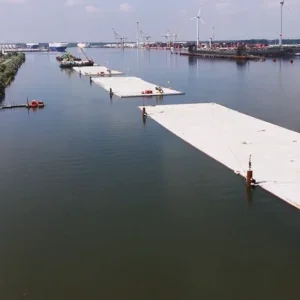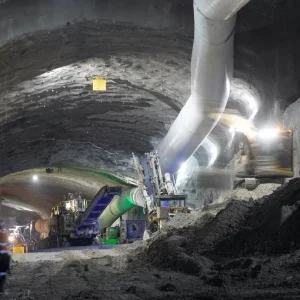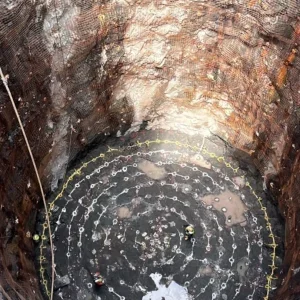New York City Department of Environmental Protection (DEP) announced on 14 May 2020 that the final segment of steel lining had been lowered into the Delaware Aqueduct Bypass Tunnel.
A total of 230 massive steel liners –16ft diameter and 40ft-long – had been lowered down the shaft. Workers began transporting them in October 2019 from a storage site in Newburgh on the Hudson River. DEP said it had expected to complete the installation of steel liners by August but laborers finished this vital portion of the US$1bn project several months ahead of schedule.
“I want to congratulate the engineers, laborers and other construction experts whose excellent work continues to advance the Delaware Aqueduct repair on budget and on schedule,” DEP commissioner Vincent Sapienza said. “A project this large includes many milestones. Safely shipping, lowering and welding these massive steel segments is one of the most important [aspects] because the steel lining will provide structural integrity to the Delaware Aqueduct, helping it serve New Yorkers for many generations to come.”
The Delaware Aqueduct Bypass Tunnel is the largest repair project in the 178-year history of New York City’s water supply system. Its centerpiece is a 2.5-mile-long bypass tunnel that DEP is building 600ft under the Hudson River from Newburgh to Wappinger. When the project is finished in 2023, the bypass tunnel will be connected to structurally sound portions of the existing aqueduct on either side of the Hudson River to convey water around a leaking section of the tunnel. The 85-mile-long Delaware Aqueduct, the longest tunnel in the world, typically conveys about half of New York City’s drinking water each day from reservoirs in the Catskills.
The project’s TBM completed excavation of the tunnel on August 13 2019. It excavated 12,448ft over the course of 582 days, starting below Newburgh, going east to an access shaft in Wappinger. The TBM installed precast concrete rings to line the tunnel in the shale and limestone bedrock. The second lining of steel segments will line 9,200ft of the new tunnel, and will later be coated with a second layer of concrete. This ‘triple-pass’ design will provide the bypass tunnel with structural stability and prevent leaks from occurring in the future.
The US$30m TBM arrived at the worksite in Newburgh in 2017. Around 21ft in diameter, it was built to withstand more than 30 bar of pressure because workers encountered huge inflows of water under immense pressure when the aqueduct was first built more than 70 years ago. The TBM was equipped with pumping equipment to remove up to 2,500 gall/min of water away from the tunnel.
Delaware Aqueduct Repair
DEP has monitored two leaking sections of the aqueduct since the early 1990s. These release an estimated 20m gallons/day, of which 95% escapes through a section of tunnel near the Hudson River in Newburgh. In 2010, the city announced a plan to repair the aqueduct by building a bypass tunnel and the project began in 2013 with the excavation of two vertical shafts in Newburgh and Wappinger. These shafts, 845ft and 675ft deep respectively, were completed in 2017.
The existing aqueduct has stayed in service while the bypass tunnel is under construction. However, once it is nearly complete and water supply augmentation and conservation measures are in place, the existing tunnel will be taken out of service and excavation will begin to connect the two components. The project will mark the first time that the Delaware Aqueduct will have been drained since 1958.
In 2013, DEP installed new pumps inside a shaft at the lowest point of the Delaware Aqueduct to dewater the existing tunnel before it is connected to the new bypass tunnel. Those pumps will be tested several times before the tunnel is drained in 2022.
The nine pumps are capable of removing a maximum of 80m gallons/day of water from the tunnel—more than quadruple the capacity of the pumps they replaced from the 1940s. The largest of the pumps are three vertical turbine pumps that each measure 23ft tall and weigh nine tons.
The Delaware Aqueduct Bypass Tunnel is the first tunnel built under the Hudson River since 1957, when the south tube of the Lincoln Tunnel was finished.







